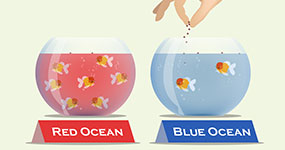Blue Oceans vs. Red Oceans

Blue Oceans are defined by creating new market space in existing markets, and are generally created by expanding existing industry boundaries by providing new value (value propositions) at an overall lower cost.
By contrast, Red Oceans consist of industry players who generally provide the same or similar value by competing within an existing set boundary of offering characteristics. While it is important to out-compete competitors where realistically possible, that plan is usually insufficient to create new growth and desired long-term profits from Red Oceans.
The concept of Blue Oceans is not new, but the use of tools to help find a new basis of competition or a new strategic direction is what makes it different. The Breakthrough Innovation Hub™ is an even more powerful addition to seeking and evaluating Blue Oceans.
Swim in a Blue Ocean (Strategy)
What are the essential elements of Blue Ocean Strategy work?
Instead of focusing on beating the competition, make the competition irrelevant by creating a leap in the value customers will have for the offering. Value innovation is created when a company's actions address both its cost structure and value proposition.
Use a defined methodology with analytical tools.
Underlying principles drive effective execution of the Blue Ocean strategy.
A primary tool of Blue Ocean is to create a strategy canvas that portrays the relative performance of the existing competitors compared to the offering characteristics provided to the market. With Red Ocean, the actual performance tends to track each other with one competitor leading on some characteristics and other competitors leading on other characteristics. The point is that they all are similar. Blue Ocean is where a competitor is clearly distanced from the others.
Data collected and analyzed using the Breakthrough Innovation Hub can display the strategic canvas and, thus, identifies Red Ocean and Blue Ocean opportunities. Blue Ocean opportunities can be enhanced by concept tests, also included in the Breakthrough Toolkit design.
The Strategic Canvas
The strategic canvas serves two purposes:
of play in the known market space, allowing clearer understanding of where you and your competitors currently compete on products, services, delivery, brand, etc., and what the customers receive from each existing competitive offering
where new value can be created by redefining the industry issues and reconstructing customer values
The evaluation of customer value elements uses a “Four Actions Framework,” a straightforward approach to answering four questions:
- Which factors that customers take for granted should be eliminated?
- Which factors should be reduced well below the industry’s standard?
- Which factors should be raised well above the industry’s average?
- Which new factors never offered by the industry should be created?
Again, the Breakthrough Innovation Hub, with Voice of the Customer (VOC), aids in assessing each possibility using the competitive performance vs. customer importance scores and, more importantly, the Feature/Benefit Value Assessment.
Evaluating the strategic options resulting from this work requires a deep understanding of the basis for market behavior. The Breakthrough Innovation Hub incorporates both a value segmentation analysis and an “attitude and trends” VOC evaluation. These, along with customizable exercises, provide a strong basis for making strategic decisions. The results of these evaluations help generate the organizing principles that establish “Strategic Intent.”
The acid test of a Blue Ocean Strategy is that it must have focus, diverge from the other players, and have a compelling tagline. Analysis generated from the Breakthrough Innovation Hub describes the important elements on which to focus, characterizes the opportunity compared to the competition, and provides the basis (value proposition) for a compelling tagline. However, it does not produce a strategy.
A related process not included in Blue Oceans Strategy is the Future Business History℠, which we designed and use for clients striving to define breakout strategies. This framework translates the learnings from the Blue Oceans work into a strategic architecture that can drive both the functional strategies and successful strategy execution into the market place.

In the example above, customers were asked to rank the relative importance of a set of attributes, and then score the performance of the client’s competitors. It is clear that, although different competitors performed at slightly different levels on specific attributes, they generally were perceived as similar in performance. However, a new value proposition introduced for evaluation vs. the existing attributes scored very high, and no competitors offered the new value proposition.
Read more about Blue Ocean strategy: Blue Ocean Strategy: How to Create Uncontested Market Space and Make Competition Irrelevant by W. Chan Kim & Renee Mauborgne




